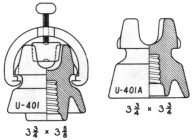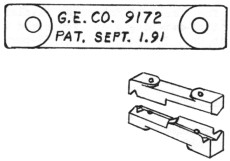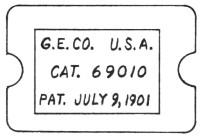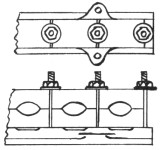Porcelain Insulator News
by Jack H. Tod
Reprinted from "INSULATORS - Crown Jewels of the Wire", July 1977, page 24
Dear Jack:
I thought I'd let you know of a couple of good ones I came up with
a while back that I haven't heard about lately -- a couple of white U-274, 0. P.
Co.
I bought a fellow's extras, and he wanted me to evaluate his porcelain and tell
him what they were and so forth. After about a year I made an offer to him, and
he took it. Boy did I raise some eyes at the show in Maumee (Ohio). I've kept
one and sold the duplicate.
Just thought I'd let your readers know there's good
ones to be found yet.
Michael T. McLaughlin
Warsaw, Indiana

Dear Jack:
I recently traded for and bought three U-780 Lapp #588A insulators
in white with blue markings. I haven't seen white Lapps before and wonder
if they occur in other designs? Also, have you or any other collectors
reported U-780's with Lapp marking?
These evidently came out of an Illinois
Power Company substation near or in the Galesburg, Illinois area. The two men I
got these from were members of the same substation crew.

I have located a line
which had U-401's and U-401A's all installed (as regular cable insulators)
without clamps. The line has been wrecked, and I think almost all of them have
been dumped in a landfill. I was fortunate to secure one specimen of each,
but no more. I have offers out to the linemen involved, but so far no
other specimens have turned up. I guess that is why many insulators are so
scarce!!
Jim Woods
Galesburg, Illinois
- - - - - - - - -
Dear Jim:
Yes, others also have U-780's with Lapp markings, but I can't recall having
seen them in white before. These were a Lapp catalog item in the 1923-1928
period, and Pinco also made and cataloged the same general style.
Practically all the smaller pin types made by Lapp also came in white, and
some styles were made in blue.
Lots of luck in trying to come up with some of the U-401 and U401A's -- still
very scarce items. (When it comes down to U-401's in a landfill -- have backhoe,
will travel!)
Some of these old Fay Clamp Insulators could still be in use somewhere as
ordinary cable insulators, but we probably have little hope of ever coming
across a batch with the clamping arrangements as originally sold.
Jack

Dear Jack:
I'm enclosing sketches of an unusual reversible wiring cleat we have with
Sept. 1, 1891 patent date, and wonder if this one has been reported before. We
also have an identical one but which is embossed "GEC 9172 / USA".

We also have this #69010 item which has one large, corrugated conductor
groove such as one-wire cleats, but also the slot in each end. Would this be
some form of one-wire cleat?
We are out of the winter deep freeze now and are both out looking for
insulators. We've come across several other cleats which have manufacturer's
markings we can't decipher, and maybe you can help on these.
One is a B & D No. 2 one-wire cleat (Pat. 8-13-95) with a Circle-K
marking embossed on one corner of top surface.
Second is a B & D No. 2-1/2 one-wire cleat (Pat. 8-13-95) with a 'U. E.
P." marking on the mating surface.
Lastly, a B & D No. 4 one-wire cleat with "O P CO", and would
this be Ohio Porcelain Company?
Anthony & Emma Almeida
Shrewsbury, Mass.
- - - - - - - - - -
Dear Anthony & Emma:
The G.E. #9172 is an unusual cleat. There were many
of these in the old porcelain plant dumpage at Peru, Indiana, and I've also seen
them in junk boxes at flea markets. Also unusual is the fact that the 9-1-91
patent date is incorrect on it, being for an entirely different cleat -- and
which I have never seen yet. The correct patent is #518,301, April 17, 1894,
Herbert C. Wirt (Boston), assignor to G.E. Co., also Boston (!). The small
sketch above is from the patent drawing in the Official Gazette.

Your G.E. #69010 item is part of a rack insulator arrangement, and I1ve shown
at the right the drawing from the patent -- #678,042, July 9, 1901, Howard H.
Sargent, Schenectady, assignor to G. E. Co., New York. As with similar Fletcher
assemblies, it must have been quite a frustrating job to install these.
Yes, the "O P CO" marking is for Ohio Porcelain Company. The
Circle-K marking is for "Kan't tell you", and the "U. E. P."
marking is for "Unsolved Embossing Puzzler". If you want to play the
initial-matching game, you could try Union Electrical Porcelain Co., Trenton,
N.J. (1959-current); before that it was Union Electrical Porcelain Works.
Jack
Dear Jack:
....Do you know if anything interesting has been written on porcelain strain
insulators? I happen to collect these as a sideline and have about 120
different. Does anyone else out there happen to save these dudes, instead of
throwing them away?
Don Fiene,
Knoxville
- - - - - - - - -
Dear Don:
You're just part of the crowd. I really don't know any porcelain buffs who
don't also collect other line insulators such as strains, rack spools,
wireholders, etc. Some even collect all types of line insulators --
arrestors, switch and bus items, etc.
I think most of us collect just whatever specimens that appeal to us and
which we bump into in our travels. Except for collectors specializing in
insulators of certain manufacturers, you usually don't see collectors running
want ads for specific strains and rack spools like you would for pin type
insulators wanted.
It's a bit more difficult to mail trade strains, since there is no style
chart for them, the variety is rather large, and most of the early ones are
No-Names. Modern and current strains are generally standardized for size and
style, and all are generally marked with a company name.
Some porcelain books have scattered material on strains, and we've run bits
and pieces on them in CJ, but there hasn't ever been any concentrated material
published on them. Guess we just never seem to get around to covering all
fronts. Maybe someday??
Jack
Ih the Feb 1977 Crown Jewels I ran an ad to sell a set of Cross
Arms magazines 1972-75. They went instantly on the first long distance call,
and there were a couple of other calls and several letters (some with checks)
wanting them. If anyone else has a set to sell, a CJ ad would bring instant
results. Likewise, those wanting to buy a set should place a wanted ad in CJ
(and I suggest '1write first" wording!).
SHORT CIRCUIT. I recently sold an insulator for $5 (plus postage), and
thought I should rinse off the dust before packing it to mail I accidentelly
dropped it in the sink. The porcelain insulator survived, and I mailed it. In
the same outgoing mail was my order to Sears for a new sink -- only $43 (plus
freight). Oh well, can't win 'em all.
Dear Jack:
It's been awhile since I last wrote you and after reading The Porcelain
Corner in the April '77 CJ (re "segmented" threads in certain
porcelain styles), I rechecked a few of the insulators in my collection and made
some discoveries I wasn't aware of.
Last summer I found several insulators in an old power-house in the
Telluride, Colorado area. They were grouted onto steel pins with sulfur which
were, in turn, embedded in concrete. They had special fittings clamped onto then
which allowed a steel rack to be bolted to the fittings. Apparently the old
style "cone type" lightning arrestors sat on this rack.
Nearly all these insulators had already been broken by someone, and with
difficulty I removed the remaining unit by breaking the steel pin. I later
managed to remove the broken pin, and much to my surprise I found that the
threads were segmented into four parts.
These insulators were similar in style to the U-958 but were single grooved
instead of crosstops, and the crown groove was larger. I an convinced that all
these similar styles were manufactured with segmented threads for a definite
purpose. Just what that purpose was is still speculation. I do have one theory,
so I'll try it out on you.
It's been my experience in collecting insulators in this area that these
insulator styles were used primarily in powerhouses, junctionhouses, etc. for
special purposes -- as on lightning arrestor mountings, or on routing of heavy
conductors throughout the building.
Some of the components of these early devices had to be aligned with other
parts, and ordinary insulators, even if grouted onto pins, could become loose
and accidentally rotated out of proper orientation. However, if an insulator
with the deformed ("segmented") threads is grouted onto a pin, there
is no way it could be accidentally rotated. Similarly, all these pins I
have seen grouted into the insulators are either oval in nature or have grooves
to prevent slippage.
In summary, it seems to me that it fits together that these particular styles
mostly have segmented threads, and they were styles favored as "equipment
insulators" which were grouted onto pins -- much the same as sanded-hole
insulators are currently used.

I recently found another insulator that I don't think is listed yet, and I've
enclosed a drawing of it. At first I thought it was your U-954A, but it is quite
different. The glaze color is brown, and I think the style and glaze type
indicate it is a Thomas product. One of the enclosed photos (taken in 1913)
shows a dozen of these in use on a line above Telluride. Needless to say, they
have all disappeared.
Phil Loos,
Durango, Colo.
- - - - - - - - -
Dear Phil:
I'm almost certain you are correct in that the fluting of the threaded pin
holes in these certain styles was for the purpose you described, and possibly
our readers will agree that this looks like you've found the logical answer to
this long tine puzzler.
I agree with you that the above glazeweld looks like a Thomas item, and how
'bout U-954B for it in the Style Chart?
Many thanks for sending the old photos from your collection for me to see,
and I'm returning them per your request. They accurately record the construction
detail in the powerhouses and lines in your area in the early days. Insulator
detail shows clearly with a magnifier, but it wouldn't come out meaningfully if
we printed them here.
Jack
| 